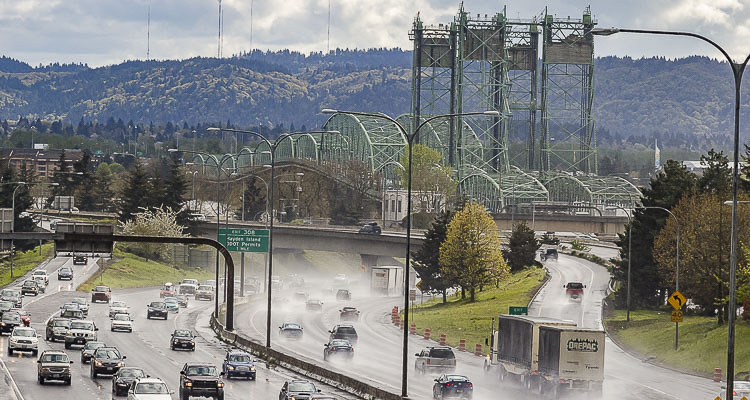
Donaghy’s comments at Sept. 13 C-TRAN Board of Directors meeting included a report of ‘breakdowns in communication between IBR and partner agencies’
Just two months after members of the C-TRAN Board of Directors voted 8-1 to support the Interstate Bridge Replacement Program’s (IBR) Modified Locally Preferred Alternative (LPA), C-TRAN CEO Shawn Donaghy has expressed more concerns with elements of the project to replace the Interstate 5 Bridge.

Donaghy, who also shared concerns about the project with Clark CountyToday in May, spoke at a meeting of the C-TRAN board on Sept. 13. In his comments, he shared that communication since the board members voted to support the LPA has led to his concerns.
“There has been a lot of communication behind the scenes since,’’ Donaghy said at the Sept. 13 meeting. “Some things have been a little concerning, either in breakdowns in communication between IBR and partner agencies or maybe expectations of the program.”
Donaghy also reminded the members of the C-TRAN Board of Directors that the agency holds a great deal of power in the final approval of the project.
“We want to do this in partnership,’’ he said. “But the reality is that C-TRAN has the right to refuse all of it. Period. The reality is this is our public transportation benefit area, and no one can operate in our public transport area without our expressed approval or design action.”
In May, Donaghy told Clark County Today that any extension of light rail into Clark County needs to be managed and operated by TriMet, not C-TRAN, or even a combination of the two agencies. The light rail element of the IBR’s LPA is still the source of many of Donaghy’s concerns. One of those involves Clark County residents being taxed for the operation of an extension C-TRAN doesn’t operate.
At a June 17 meeting of the Bi-state Bridge Committee of 16 Oregon and Washington legislators, TriMet’s JC Vannatta, executive director of Public Affairs, said TriMet would not cover operation and maintenance costs for the portion of light rail in Vancouver. “We don’t have detailed cost estimates or cost sharing plans yet,” he said. “This too will be a critical element of the project’s next phase.” Vannatta further expects the capital costs to build the three-mile light rail extension into Clark County will be between $1 billion and $1.3 billion. The new taxes will have to come from both sides of the Columbia River.
Donaghy told Clark County Today Thursday that “while C-TRAN understands that there will need to be identification of funding sources for the operation of this extension, C-TRAN in Board meetings and conditions within our LPA note that we do not believe that the citizens of Clark County should have to financially support a mode that C-TRAN does not operate. We are open to having conversations with our partners on how to best solve those opportunities, but our position has been noted. C-TRAN for many years has provided service to connect our riders to Portland through C-TRAN funding.’’
Clark County Today also asked Donaghy if he believed C-TRAN’s Bus Rapid Transit offers better and more flexible service than TriMet’s light rail?
“I share the same goal as all of our partners within the project that we are building a bridge for the next 100 years,’’ Donaghy wrote in an email response to Clark County Today. “C-TRAN believes that connecting all modes of transportation is critical within this project, including the Modified LPA agreement which notates light rail connecting with our Bus Rapid Transit and existing Bus network here in Vancouver, while also maintaining our Express Bus/Bus-on-Shoulder network.
“Our goal is to see a finished product that includes ALL modes of transit working together to provide options for citizens on both sides of the river,’’ Donaghy said. “This is not specific to Bus Rapid Transit, or Light Rail. Finding the best location, and connecting these modes together is critical for the future of our region. This includes walkability, bike, bus, rail, car, and any other mode of transportation that can be offered. It’s about creating choices for better transportation.’’
C-TRAN has been able to build two BRT lines to serve Clark County residents for $50 million each, without raising taxes on area citizens. Clark County Today asked Donaghy which would be a better value for Clark County citizens, a C-TRAN BRT line into Portland, or a $1.3 billion three-mile light rail extension into downtown Vancouver?
“As noted before, the ‘value’ that exists is the integration of transit choices and options for all of our citizens – in whatever mode capacity that may be for them,’’ he said. “When thinking about the Bus Rapid Transit network, it would need to operate within its own dedicated guideway, which is a much higher cost than the Bus Rapid Transit projects we have done locally – so I would offer that the comparative is a little different than our local projects.’’
Donaghy said he didn’t have any details regarding the cost of the proposed new “lid” over I-5 at Evergreen Blvd. or any details relating to the possible cost of an “elevated” light rail station versus an “at grade” station at that location.
“At this point, it is a discussion item to be explored within the SDEIS (Environmental Impact Statement), which will give us information downline regarding costs and other items,’’ he said.
Even though Donaghy did express concerns to Clark County Today in May, he said the concerns he has now expressed after the Board of Directors’ vote in July are the result of updates that have been communicated since the vote.
“We have given several updates regarding the IBR at our Board Meetings leading up to the approval of the Modified LPA in July,’’ he said. “The items specific to comments at the Board meeting reflect work being done after the partners approved the MLPA to build a template for SDEIS.’’
In his comments to Clark County Today, Donaghy did profess the belief that the communication breakdown with the IBR program team and Administrator Greg Johnson that has led to his concerns are repairable.
“It is not lost on me that there are several different teams within the IBR structure that (are) working diligently to help push a project forward with our partners,’’ Donaghy said. “It is also worth noting that they are working through 170+ conditions that were given to them at the time of MLPA approvals from all of the project stakeholders. We just need to ensure that SW Washington’s voice is heard, and that our project points and ideas are being incorporated into planning phases before it is difficult to change or modify them.
“Our cities and county representatives have a great deal to be proud of regarding the work done to bring infrastructure, opportunities through employment, and livability into Clark County – and we need to make sure that this bridge supports their hard work and efforts,’’ he said. “The program has committed to making sure that their teams will continue to work closely with ours and ensure that we are sharing the necessary information to keep our stakeholders and boards advised – and I appreciate that commitment from Administrator Johnson.’’
Also read:
- Delays expected on Northwest 99th Street during water quality project constructionClark County will begin construction in July to install a stormwater filter vault on NW 99th Street. Drivers can expect delays, but lanes will remain open during the work.
- POLL: What’s the biggest concern you have with the current I-5 Bridge replacement plan?As costs rise and Oregon’s funding fails, concerns mount over the current I-5 Bridge replacement plan. Clark County Today asks readers: what’s your biggest concern?
- Plan ahead for ramp closures on I-5 near Ridgefield, July 8-9Travelers on northbound I-5 near Ridgefield should prepare for ramp closures July 8–9 as WSDOT crews conduct final testing of new wrong-way driving detection systems. The closures affect exits 9 and 11, including the Gee Creek Rest Area.
- Oregon DOT director calls transportation funding bill failure ‘shocking,’ warns of layoffsODOT Director Kris Strickler warned staff that up to 700 layoffs are imminent after lawmakers failed to pass a transportation funding bill, deepening the agency’s $300 million shortfall.
- New crossing opens over SR 500 in VancouverWSDOT has opened a new pedestrian and bike bridge over SR 500 in Vancouver, restoring direct and ADA-accessible access for people walking, biking, or rolling.









